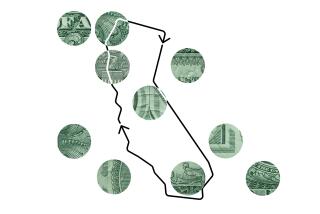Lender 2.0: Kiva’s Premal Shah
I could just see the eyebrows rising around the room. I was moderating a panel on philanthropy not long ago, and on my left, Premal Shah, the president of Kiva.org, was talking animatedly about how much fun Kiva donors had, competing with each other, in teams, to see who could do the most good. Fun? This is not your father’s philanthropy. Shah”s online matchmaking philanthro-banking site lets people in the donor door for as little as $25. Kiva posts loan appeals from thousands of worldwide “entrepreneurs” on the site -- Shah doesn’t call them “the needy” or any other such term. Prospective lenders log on, pick their favorites and a match, in the form of a loan, is made. Shah himself is among Silicon Valley’s “PayPal mafia,” young men and women who took know-how from working at PayPal to their own pursuits. In his case it was Kiva, a Swahili word meaning “unity” or “agreement” -- $25 at a time.
How does Kiva work?
Kiva is kind of like EBay for micro-financing, for social lending. It’s run by a nonprofit organization. On its website, you can browse through profiles of entrepreneurs. You pick, you make a loan. The average loan term is about 10 months.
So say you want to lend to a woman who wants to buy a cow to start a dairy business. She starts selling milk at the market; she starts making repayments. You get a repayment back every month. If you lend $25, every month you’ll get $2.50 back. There’s a 98% repayment rate now. You can re-lend that money to another entrepreneur, which is what 88% of people choose to do, or you can withdraw that money.
Last fall we added students. Student loans largely don’t exist in the developing world. There are about 100 students who have received a Kiva loan in four different countries; if they repay on a high level, I think other sources of capital will come.
How do you know these people asking for loans are for real?
We’re working with field partners. They’re the ones vetting each entrepreneur or student, posting the photos, collecting and disbursing the money. We have about 130 of those organizations in 58 countries. Kiva vets the field partner organization; it’s very rigorous due diligence. It is [the partner organizations’] job to figure out which entrepreneurs need a loan and can handle it responsibly. These partners charge an interest rate [to] help cover their costs, like going out to the rural village. Kiva doesn’t charge an interest rate. It’s zero-percent-interest lending. It’s the space between a donation and a commercial investment that we’re trying to pioneer.
You’re a native of India, an alum of Irondale High School in Minnesota, and you graduated from Stanford in 1998. Tell me how you got from there to here.
When I was a year old, my parents immigrated to the U.S. and, of all places, they landed in Minnesota. My dad is a mechanical engineer; my mom was a civil engineer.
When I was 5 years old, my parents [took me] to India for the first time. I remember walking in a village market with my mother. Like many villages in India, there’s a sewage stream right through the center of the village. My mom [gave] me a rupee coin. One rupee was worth less than a cent at the time. I’m a little kid and that coin slipped out of my hand and rolled near the sewage and my mom yanked me away because she didn’t want me to chase after it. I remember a woman almost the age of my grandmother, in a very ragged sari, went over to that stream, picked up that one-rupee coin and looked up at the sky and thanked God. I come back to Minnesota, in the back of my mind thinking one day I want to do something about this.
It really did stay with you?
I learned about microcredit at Stanford; I was studying economics.There’s this great quote: “Don’t ask what the world needs, ask what makes you come alive.” It totally describes what happened.
I was in the middle of a sophomore slump and I saw this incredible approach [to poverty] by Muhammad Yunus. By the time I was a senior, Stanford gave me a grant to research microfinance in India.
I joined PayPal early on. The fifth year I was at PayPal, they gave me a sabbatical. This really changed my life, being able to get out of the cubicles and go to India. By day I worked with a women’s economic cooperative to help them sell their silk works on EBay, and by night I [planned] how we’d allow people to make loans via PayPal and EBay to the women I was working with. I came back to the U.S. very excited about this idea of online person-to-person micro-finance. Matt Flannery and Jessica Jackley [launched] Kiva in October 2005. We became really great friends.
You mention Muhammad Yunus, Nobel Prize winner for his microfinance bank in Bangladesh. Authorities there have removed him from the bank because of his age; they talk of irregularities. What do you make of what’s happening to him?
It’s really hard to say with any certainty hey, this is right, this is wrong. I will say, though, in my own personal interactions, he is a saint. There’s been a lot of people who’ve commented that this does seem like a very political act by the government. I hope it resolves in a good way. We’ve tried to support him as much as we can.
There’s a sense of playfulness and competition on Kiva.
We’ve been intentional about not underestimating fun. We have all these lending teams, over 15,000 on the Kiva platform. It’s the lenders who form their affinity groups; like the atheists and Christians competing for the top spot. Or women who lend to shirtless men. A group of women noticed a lot of [photos of] men who don’t wear shirts who are looking for loans, particularly in Southeast Asia, and they created a team and made that something they look for. There’s another group focuse[d] on baskets in the picture. You connect with people and go about making an impact together.
Why should that be part of philanthropy?
It’s something that definitely appeals to people. The things you find on other websites -- why can’t we find this in philanthropy and build a community around it? We see people almost literally addicted to Kiva. They’ll wake up in the middle of the night [and read] a chat-room message board.
People love the information that’s contained in the loan. When you start getting repayments, that lets you know something’s working on the ground. Conversely, when you don’t get repaid, that’s also a tangible feedback loop and the explanation of why -- maybe the person got malaria or the cow died -- and I think that feedback loop is so often missing in philanthropy.
What’s the difference between the Facebook generation and the baby boomers when it comes to giving?
I would say this is not Facebook versus baby boomer. Our users -- over half of them are over 40. I think it’s more a universal need to get closer to what’s happening, and get some kind of feedback, and more and more philanthropy is moving in this direction.
What has surprised you most about Kiva?
It’s the idea of being co-owned and co-created by a community of people.
When I quit my job at PayPal, no one was coming to this website. It was like crickets and tumbleweeds. It wasn’t until the end of the first year that things really started to get going. [Now] we’re seeing things like people creating their own Kiva Japan site. Someone just got a Kiva tattoo. I saw a photo of a Kiva license plate in Virginia.
Here’s the difference between classic organization thinking and Kiva: Many organizations can be kind of command and control: “We license our brand, here’s all the rules, stay on message, blah blah blah.” We let people mash it up. There’s no brand police around. It’s “go and create things around the common purpose of making an impact.” This is our moment, a chance to do some really amazing things.
Does this mean you’re putting the more traditional, bricks-and-mortar philanthropies out of business?
Oh no. In fact, I think we’re helping them to be more efficient. Probably one of the best things they could do is [use] the Internet to reach people, [to] explain the stories not [in] a once-a-year annual report but on an everyday basis. I see them using platforms like Kiva, like Facebook, like YouTube to get their great work out there and help them fundraise.
A one-person, $25 loan can’t achieve massive change, as did some American CEOs who, in one act, preserved 2 million acres in South America.
Let me talk about what you might see in the next 10 years: [A] website that takes photos of plots of land that need protection and sells the deeds to the Internet community. In $25 chunks, I can help protect the rain forest. Through Google Earth and GPS technologies, you could actually [see and] own one square foot of land in the Brazilian rain forest. Someone will do this.
We think of ourselves as a donor nation, not a needy one, yet people in the U.S. are soliciting loans through Kiva.
Our 47th country was the United States. The reason is that 2008-2009 was an incredibly difficult time. If you were a small business and you didn’t have swell credit scores, banks wouldn’t lend to you. We know that small businesses are the backbone of the economy, and there are about 30 million small-business owners who are unbanked or under-banked in the U.S. We said, why not let the Internet community bank on people here in the U.S.?
We found that many first-time users who made a loan to a U.S. business tended to add loans to other people around the world. I think people want to help locally, and, when they’re engaged, they’ll help people around the world.
Why do more women get Kiva loans than men?
Women are oftentimes the people to whom banks would never lend. Yet studies have shown that when you help a woman, you really help a family; that when loans are made to women, the nutritional outcomes, the incidences of children going to school, tend to be higher than when you lend to men, so the social impact of lending to women, it appears, is higher.
And then the repayment rates [from] women tended to be higher. We have a 98% repayment rate, and it’s because, I believe, a majority of loans go to women. I don’t want to speak badly of men, but oftentimes there are problems; they can spend money on a lot of different vices. Women tend to feel much more responsible for the well-being of the household.
This interview was edited and excerpted from a longer taped transcript. Interview archive: latimes.com/pattasks.
More to Read
A cure for the common opinion
Get thought-provoking perspectives with our weekly newsletter.
You may occasionally receive promotional content from the Los Angeles Times.







